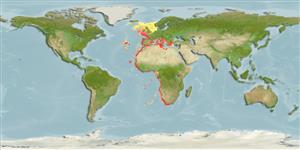Common names from other countries
Environment: milieu / climate zone / depth range / distribution range
Ecologia
; intervalo de profundidade 10 - 1212 m (Ref. 435), usually 80 - 350 m (Ref. 435). Temperate; 64°N - 36°S, 34°W - 29°E
Eastern Atlantic and the Mediterranean: from Morocco to Angola and off lying islands, northwards to Hebrides and Southwest Norway, also in Mediterranean as far as Greece.
Length at first maturity / Tamanho / Peso / Idade
Maturity: Lm 7.2 range ? - ? cm Max length : 21.5 cm CL macho/indeterminado; (Ref. 435)
Maximum depth from Ref. 106053. In bathyal oceanic communities (Ref. 96584). Occurs at depths from 10 to 1000 m, common at depths of 80 to 350 m (Ref. 435). Deep-water species, recorded down to 1212 m. Found in the shelf (Ref. 105470), upper and middle slope (Ref. 96584). where it is abundant in the latter (Ref. 96584). Prefers intermixed bathyal mud and emerging rocky substrates. Reported to be among cold-water coral community, specifically on coral mounds and coral habitats on muddy bottoms (Ref. 96584). Also found on seamounts (Ref. 122979). Carries a sponge on its back with its fifth pereiopods. Predator of benthic decapods (Ref. 96584) and an active scavenger (Refs. 96584, 106053).
Members of the order Decapoda are mostly gonochoric. Mating behavior: Precopulatory courtship ritual is common (through olfactory and tactile cues); usually indirect sperm transfer.
Fischer, W., G. Bianchi and W.B. Scott (eds.). 1981. (Ref. 435)
Categoria na Lista Vermelha da IUCN (Ref. 130435)
Categoria CITES (Ref. 108899)
Not Evaluated
Not Evaluated
Utilização humana
Pescarias: espécies comerciais
| FishSource |
Ferramentas
Fontes da internet
Estimates based on models
Preferred temperature
(Ref.
115969): 10 - 16.4, mean 13.3 (based on 388 cells).
Resiliência
Elevada, tempo mínimo de duplicação da população menor que 15 meses (Fec=217,000).
Vulnerabilidade
Low vulnerability (12 of 100).
Categoria de preço
Unknown.
